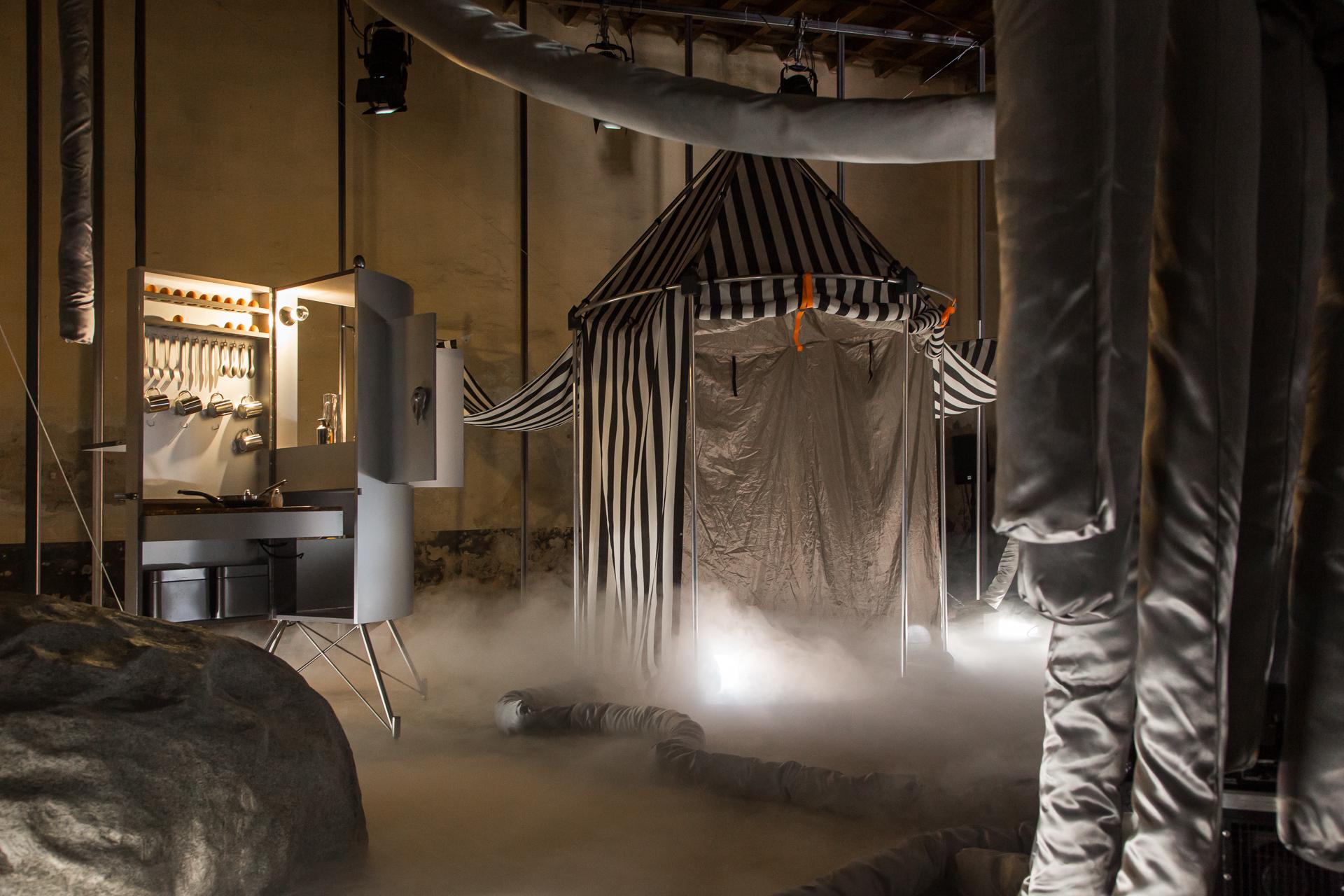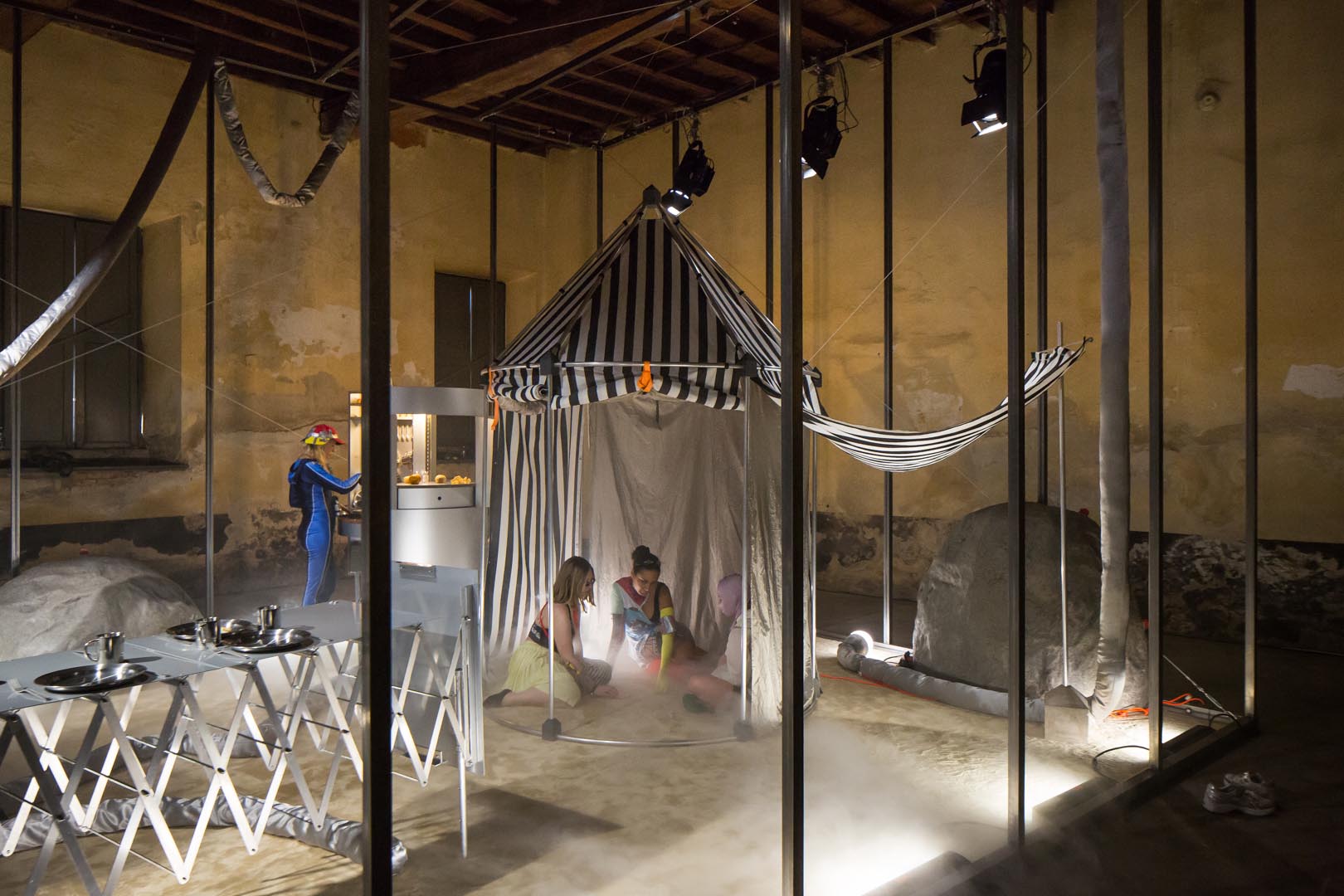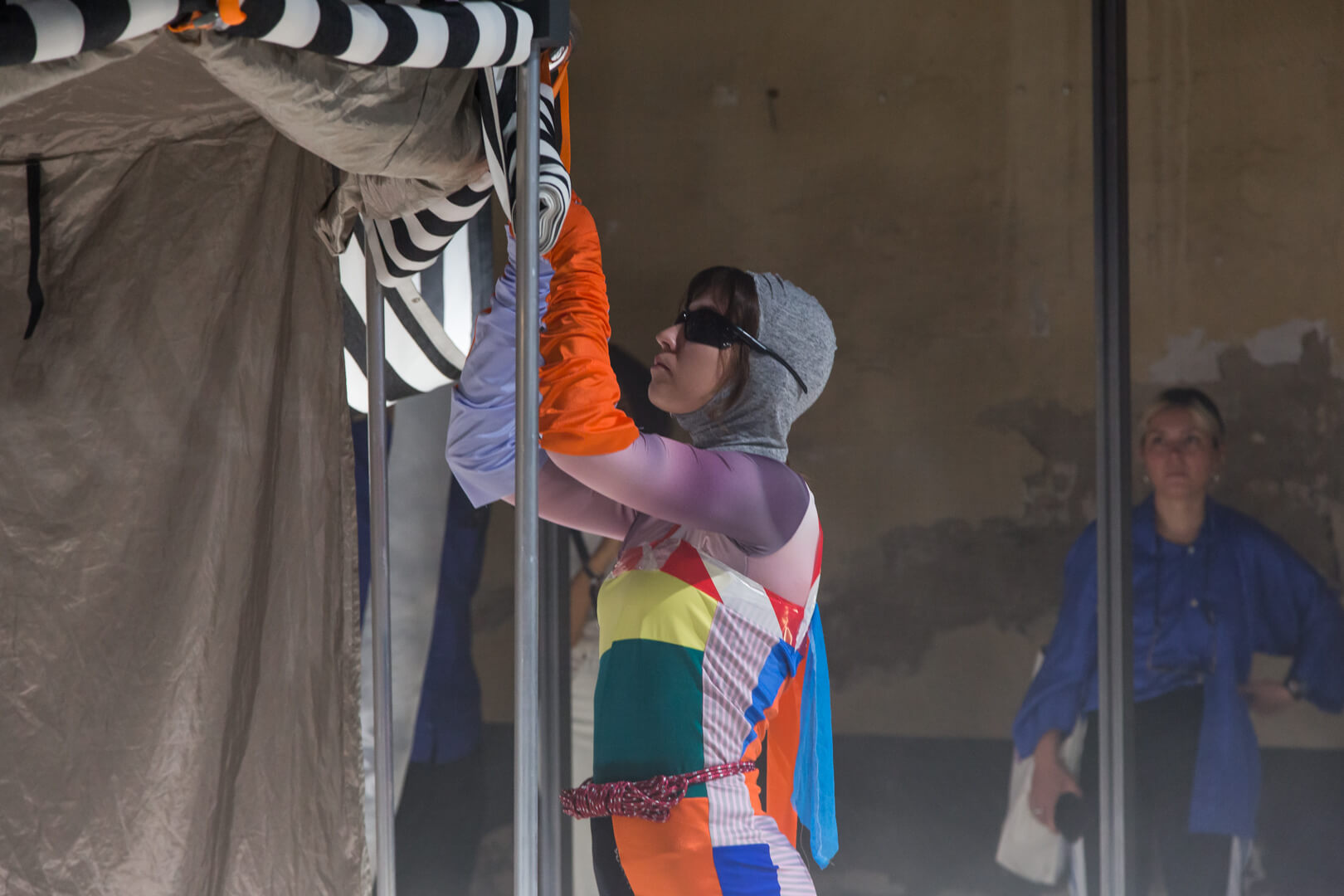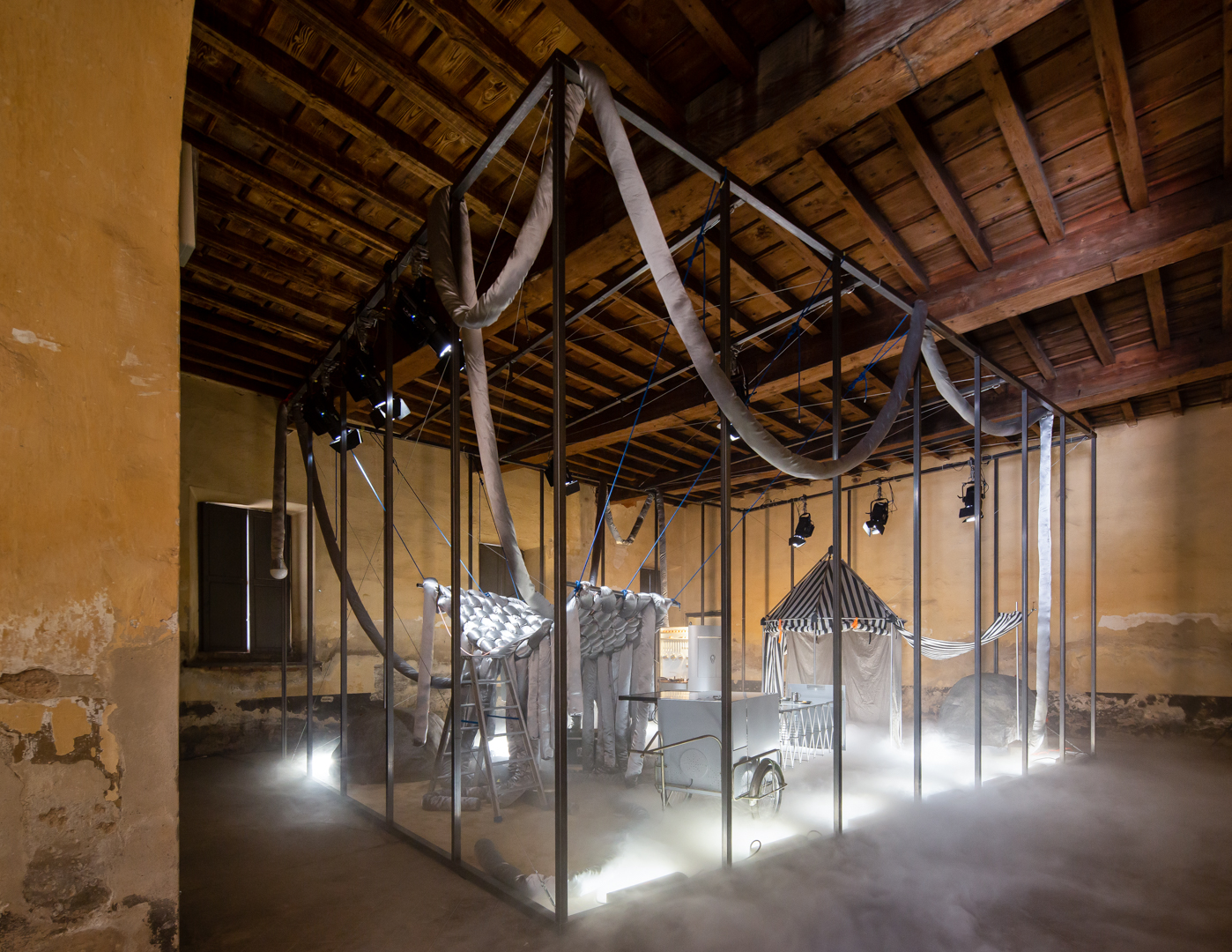Javier Fernández Contreras, PhD, is an architect, architectural theorist, and the dean of the Department of Space Design/Interior Architecture at HEAD – Genève. His work explores the relationship between architecture, representation, and media, with a specific focus on the role of interiors in the construction of contemporaneity. Contreras is the director of several academic and research programs, including MAIA (Master of Arts in Interior Architecture); The Interiors of Social Media, a project that investigates the intersections between digital media, architecture, and society; and The Future of Humanitarian Design, a program that examines how political science and design can jointly address humanitarian challenges.
2084: A DIORAMA OF THE FUTURE
2084: A Diorama of the Future is an architectural speculation on post-Anthropocene challenges, envisioning a future where some cities lie abandoned while others endure extreme climate conditions. In this scenario, a diverse group of human and non-human explorers parachutes into the year 2084, navigating survival and reconstruction. Unlike 19th-century dioramas that romanticized nature behind glass, this project transforms part of Villa Bagatti Valsecchi’s annexes into a performative device, immersing visitors in damaged landscapes while confronting environmental and societal dilemmas. Within this large space, both performers and visitors take on the role of inhabitants in a changing vivarium, whose evolution challenges the relationship between vision, habitat, and climate change.
Category: Exhibition
Team: HEAD – Genève, Interior Architecture
Awards: Nominee, Créateurs Design Awards 2025
Press: Designboom / Dezeen / hube magazine / Elle décor / Interni / Trendhunter / Adorno Design
© HEAD – Genève. Raphaëlle Mueller
2084: A Diorama of the Future is an architectural speculation on post-Anthropocene challenges, envisioning a future where some cities lie abandoned while others endure extreme climate conditions. In this scenario, a diverse group of human and non-human explorers parachutes into the year 2084, navigating survival and reconstruction. Unlike 19th-century dioramas that romanticized nature behind glass, this project transforms part of Villa Bagatti Valsecchi’s annexes into a performative device, immersing visitors in damaged landscapes while confronting environmental and societal dilemmas. Within this large space, both performers and visitors take on the role of inhabitants in a changing vivarium, whose evolution challenges the relationship between vision, habitat, and climate change.
Category: Exhibition
Team: HEAD – Genève, Interior Architecture
Awards: Nominee, Créateurs Design Awards 2025
Press: Designboom / Dezeen / hube magazine / Elle décor / Interni / Trendhunter / Adorno Design
© HEAD – Genève. Raphaëlle Mueller
Alcova / Milan, 2024
![]()
![]()
![]()
![]()
![]()
![]()
![]()
![]()








NOCTURNAL HISTORY OF ARCHITECTURE
For centuries, architectural theory has been dominated by solar and diurnal paradigms. References to night in Vitruvius' De Architectura are scarce, as they are in the Renaissance treatises by Alberti or Palladio. However, the night has been, for millennia, a central laboratory in the development of new forms of space. This book offers a first chronological attempt at A Nocturnal History of Architecture, spanning over 2000 years across different geographies and societies. From the elusive darkness of Greek temples to the overlit American suburbia, and from moon-inspired Japanese aesthetics to Italian nightclubs, it reveals how the evolution of human beings and their material environment is inseparable from the night.
Essays by: Sébastien Grosset, Efrosyni Boutsikas, Maria Shevelkina, Murielle Hladik, Maarten Delbeke, Amy Chazkel, Lucía Jalón, Carlotta Darò, Yan Rocher, Alexandra Sumorok, Chase Galis, Cat Rossi, Léa-Catherine Szacka, Hilary Orange, Nick Dunn, Youri Kravtchenko
Category: Book. English
Editor/s: Javier F. Contreras, Vera Sacchetti, Roberto Zancan
Collection: COLUMN (2)
ISBN: 978-3-95905-674-8
Research Platfom: Scènes de Nuit
© HEAD – Genève, Morgan Carlier
For centuries, architectural theory has been dominated by solar and diurnal paradigms. References to night in Vitruvius' De Architectura are scarce, as they are in the Renaissance treatises by Alberti or Palladio. However, the night has been, for millennia, a central laboratory in the development of new forms of space. This book offers a first chronological attempt at A Nocturnal History of Architecture, spanning over 2000 years across different geographies and societies. From the elusive darkness of Greek temples to the overlit American suburbia, and from moon-inspired Japanese aesthetics to Italian nightclubs, it reveals how the evolution of human beings and their material environment is inseparable from the night.
Essays by: Sébastien Grosset, Efrosyni Boutsikas, Maria Shevelkina, Murielle Hladik, Maarten Delbeke, Amy Chazkel, Lucía Jalón, Carlotta Darò, Yan Rocher, Alexandra Sumorok, Chase Galis, Cat Rossi, Léa-Catherine Szacka, Hilary Orange, Nick Dunn, Youri Kravtchenko
Category: Book. English
Editor/s: Javier F. Contreras, Vera Sacchetti, Roberto Zancan
Collection: COLUMN (2)
ISBN: 978-3-95905-674-8
Research Platfom: Scènes de Nuit
© HEAD – Genève, Morgan Carlier
(Leipzig: Spector Books, 2024)
![]()
![]()
![]()
![]()




INSTAGRAM, TIPOLOGY AND ARCHITECTURE
The Interiors of Social Media
Analyzing the most followed Instagram accounts worldwide, this essay investigates the role that social media plays in the contemporary redefinition of our material environment and its virtual boundaries. Operating within a framework of production/consumption, Instagram establishes hierarchies based on the success of content, the most valued body types, and the types of architecture presented for public consumption. From the members of the Kardashian-Jenner family to Leo Messi, and from Beyoncé to Cristiano Ronaldo, the most followed accounts predominantly feature heterosexual celebrities, reinforcing norms and stereotypes that are regularly framed within interior spaces. Addressing these interiorities through a typological classification is to recognize that they are producing architecture, and therefore spatial behaviors and norms.
Category: Essay. English, Spanish
Author/s: Javier F. Contreras, Paule Perron
ISSN: 1853-1997
Download PDF (English)
Download PDF (Spanish)
The Interiors of Social Media
Analyzing the most followed Instagram accounts worldwide, this essay investigates the role that social media plays in the contemporary redefinition of our material environment and its virtual boundaries. Operating within a framework of production/consumption, Instagram establishes hierarchies based on the success of content, the most valued body types, and the types of architecture presented for public consumption. From the members of the Kardashian-Jenner family to Leo Messi, and from Beyoncé to Cristiano Ronaldo, the most followed accounts predominantly feature heterosexual celebrities, reinforcing norms and stereotypes that are regularly framed within interior spaces. Addressing these interiorities through a typological classification is to recognize that they are producing architecture, and therefore spatial behaviors and norms.
Category: Essay. English, Spanish
Author/s: Javier F. Contreras, Paule Perron
ISSN: 1853-1997
Download PDF (English)
Download PDF (Spanish)
Burning Farm, No. 14 (November 2024) / PLOT, No. 72 (February 2024): 174-183
![]()

Screens Within Screens
THE INTERIORS OF TWITCH
This essay examines Twitch's influence on contemporary interior spaces, delving into the interplay between architecture, online interaction, and digital empathy. From its origins as Justin.tv in 2007 to its rise as a dominant platform in gameplay streaming since 2011, Twitch mirrors 20th and 21st-century TV programs in which audiences watch individuals react to audio-visual content. The research highlights the emergence of a novel, seemingly domestic landscape: the "non-circadian interior," where broadcasts within screens neither depict time nor reveal windows or daylight. By analyzing the practices of leading Twitch streamers such as xQc, Ninja, or Pokimane, the essay reveals how live broadcasts and archival content blend with architectural materials whose chromatics, reflections, and tectonics operate within the digital topos of the screen.
Category: Essay. English, Spanish
Author/s: Javier F. Contreras
ISSN: 2813 – 8058
Download PDF (English)
Download PDF (Spanish)
Twitch Analytics: Charlene Claveria, Lisa Divorne, Noémie Castella
THE INTERIORS OF TWITCH
This essay examines Twitch's influence on contemporary interior spaces, delving into the interplay between architecture, online interaction, and digital empathy. From its origins as Justin.tv in 2007 to its rise as a dominant platform in gameplay streaming since 2011, Twitch mirrors 20th and 21st-century TV programs in which audiences watch individuals react to audio-visual content. The research highlights the emergence of a novel, seemingly domestic landscape: the "non-circadian interior," where broadcasts within screens neither depict time nor reveal windows or daylight. By analyzing the practices of leading Twitch streamers such as xQc, Ninja, or Pokimane, the essay reveals how live broadcasts and archival content blend with architectural materials whose chromatics, reflections, and tectonics operate within the digital topos of the screen.
Category: Essay. English, Spanish
Author/s: Javier F. Contreras
ISSN: 2813 – 8058
Download PDF (English)
Download PDF (Spanish)
Twitch Analytics: Charlene Claveria, Lisa Divorne, Noémie Castella
Burning Farm, No. 3 (December 2023) / PLOT, No. 72 (February 2024): 164-173
![]()
